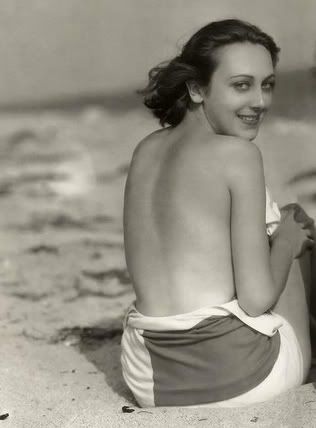 Some of my favorite Pre-Code films are the aforementioned Golddiggers; the 1932 version of Dr. Jekyll and Mr. Hyde, with Fredric March and Miriam Hopkins; and Ernst Lubitsch's Design for Living, with March, Hopkins, and Gary Cooper as a trio who devise a ménage à trois arrangement so that each man can be with Hopkins' character without ruining their relationship with one another. (The film never directly addresses the homosexual aspect of the arrangement, but Cooper and March do a lot of very close talking throughout, and both of their characters are artists, and they're frickin Gary Cooper and Fredric March, so I think we can all read between the lines.)
Some of my favorite Pre-Code films are the aforementioned Golddiggers; the 1932 version of Dr. Jekyll and Mr. Hyde, with Fredric March and Miriam Hopkins; and Ernst Lubitsch's Design for Living, with March, Hopkins, and Gary Cooper as a trio who devise a ménage à trois arrangement so that each man can be with Hopkins' character without ruining their relationship with one another. (The film never directly addresses the homosexual aspect of the arrangement, but Cooper and March do a lot of very close talking throughout, and both of their characters are artists, and they're frickin Gary Cooper and Fredric March, so I think we can all read between the lines.)
 |
| Ann Dvorak |
Three On a Match, released in 1932 and directed by Mervyn LeRoy, looks at life from a decidedly more somber point of view than Design for Living, but is no more reserved in the way it addresses taboo subject matter. The title of the film refers to the belief that lighting three cigarettes off the same match is unlucky, and that the lighter of the third cigarette will be the first to die -- in this case, the "three" refers to three childhood acquaintances played by Ann Dvorak, Joan Blondell, and Bette Davis, whose lives intertwine again as adults. I chose the film for Dvorak, who is technically the "star" of the film, with Blondell a close second; Davis, in one of her earliest screen roles, is given little to do as the brainy, reserved member of the trio. Dvorak is largely unknown to audiences today (possibly because there seems to be some confusion over how to say her name; I've only ever heard it pronounced "D-vorak," but her wikipedia page claims it's pronounced "Vor-shak," which seems a little like me deciding I'm going to pronounce my name "L'bersham"), but she was a popular star for a time in the early thirties, and she makes the most of her part in Three On a Match, playing the role of good-girl-gone-bad Vivian with an honesty that manages never to cross into the grotesque.
Unlike Design for Living, the nature of the story in Three On a Match isn't exactly racy; rather, it's the way the story plays out on screen. When Dvorak's Vivian becomes bored with her privileged life, she goes on a bender to end all benders, shacking up in a hotel with a gambler, becoming addicted to alcohol and cocaine, and neglecting to feed or bathe her young son, whom she's dragged along for the ride. We don't see much of the sexual relationship between Vivian and the gambler, but we do see her passed out on a bed with drug paraphernalia scattered all around her, and later shuffling around in a cocaine-induced haze, continuously rubbing at her nose -- none of which would have made it onscreen a few years later. The fact that Blondell's former wild child Mary becomes the hero of the film also likely wouldn't have flown with the censors, because part of what the Hays Code did, much more than censoring objectionable images, was to censor objectionable ideas, like that a bad girl could end up happy and a "good" girl could end up imprisoned in a drug den with her child, her boyfriend, and a bunch of gangsters.
Parts of Three On a Match are rather silly, especially the ending, although it doesn't play quite as silly as it would sound if I wrote it out here. Overall, it's a quick, entertaining movie, and worth watching not only to see three actresses at different stages of their respective careers, but also to look at life in the early thirties without the soft-focus lens of the Hays Code. I have a feeling that, had the film been shot just two years later, the outcome would have been very different.
Grade: B+


No comments:
Post a Comment